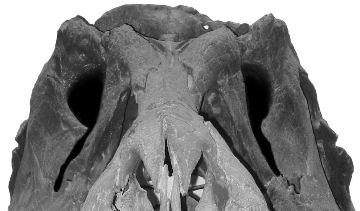Supersight for a Dino King
Tyrannosaurus rex had some of the best vision in animal history.
By Emily Sohn
The movie Jurassic Park has a scary scene in which a Tyrannosaurus rex growls right into the faces of two characters. One person tells the other not to worry because T. rex can’t see things that don’t move. Bad advice. A scientist now suggests that T. rex had some of the best vision in animal history.
 |
|
T. rex had large eyes and, as it evolved over millions of years, its snout grew narrower, which improved its vision. |
| Kent A. Stevens, University of Oregon |
Kent A. Stevens of the University of Oregon used models of the faces of several dinosaurs, including T. rex, to try to figure out how well they could see. He was especially interested in T. rex‘s binocular vision. Binocular vision allows animals to see three-dimensional objects more clearly, even when the objects are motionless or camouflaged.
It turns out that T. rex had pretty amazing vision—better than people and even hawks have. Stevens also found that parts of T. rex‘s face changed over time to help it see better. As the animal evolved over millennia, its eyeballs grew larger and its snout grew skinnier so that its view wasn’t blocked.
“With the size of its eyeballs, it couldn’t help but have excellent vision,” Stevens says. In fact, its vision was so sharp that it could probably distinguish objects that were as far away as 6 kilometers. People can do no better than 1.6 kilometers.
T. rex was a meat-eating dinosaur, but scientists disagree on whether T. rex hunted for its food or simply ate leftovers from other dinosaurs.
The dinosaur’s amazing vision has some scientists thinking that T. rex was a hunter. After all, if it ate only leftovers, why would it need to spot other animals so far away? Other scientists say that T. rex could have used its great vision for other purposes, such as avoiding trees.
Stevens says that he was inspired to study T. rex eyes because he didn’t believe that the T. rex scene in Jurassic Park was possible. “If you’re sweating in fear 1 inch from the nostrils of the T. rex, it would figure out you were there anyway,” he says.—E. Jaffe
Going Deeper:
Jaffe, Eric. 2006. Sight for ‘saur eyes: T. rex vision among nature’s best. Science News 170(July 1):3-4. Available at http://www.sciencenews.org/articles/20060701/fob2.asp .
You can learn more about Tyrannosaurus rex at www.bhigr.com/pages/info/info_stan.html (Black Hills Institute of Geological Research) and www.childrensmuseum.org/dinosphere/profiles/stan.html (Children’s Museum of Indianapolis).
Sohn, Emily. 2006. A dino king’s ancestor. Science News for Kids (Feb. 15). Available at http://www.sciencenewsforkids.org/articles/20060215/Note2.asp .
______. 2005. Dino flesh from fossil bone. Science News for Kids (March 30). Available at http://www.sciencenewsforkids.org/articles/20050330/Note2.asp .
______. 2004. Ferocious growth spurts. Science News for Kids (Aug. 25). Available at http://www.sciencenewsforkids.org/articles/20040825/Note2.asp .
______. 2003. Dinosaurs grow up. Science News for Kids (Nov. 26). Available at http://www.sciencenewsforkids.org/articles/20031126/Feature1.asp .







